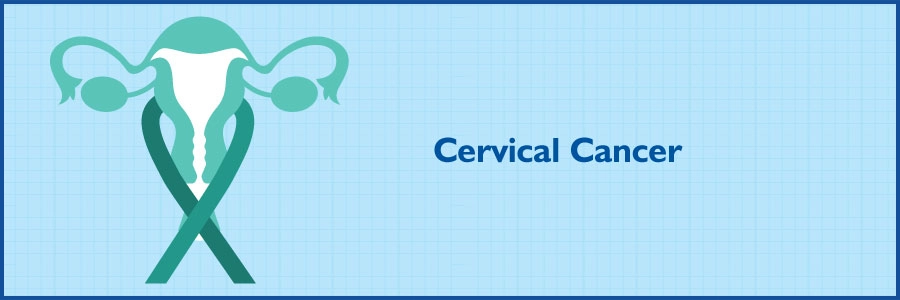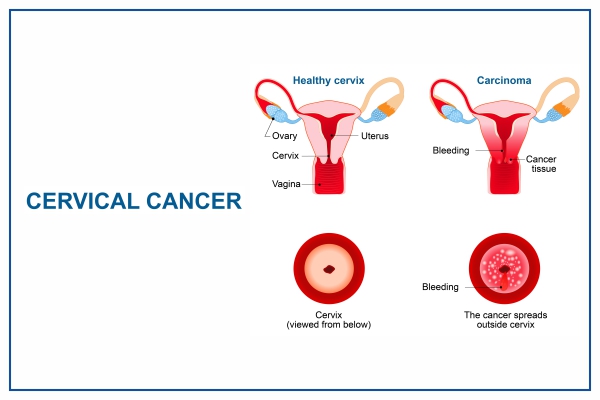
Cervical Cancer: What is it?
In India, Cervical cancer is the second most common cancer among women after breast cancer, with an incidence rate of 18.3%(123,907 cases every year) and the leading cause of death among women with a death rate of 9.1% as per GLOBOCON 2020.
Cervical cancer can be treated easily if diagnosed early. There is a lack of awareness and knowledge among women, which leads to more severe risks or complications of this disease.

Symptoms
- Bleeding between periods
- Bleeding after intercourse
- Fowl-smell Vaginal discharge
- Post-menopausal bleeding
Secure your health with a second opinion. Make informed decisions and book your appointment today!
Get A Second OpinionCauses
Cervical cancer is caused when there is an uncontrolled growth of cells in the opening or mouth of the uterus. In 99% of cases, Human Papilloma Virus (HPV) has been found to be the causative agent that is sexually transmitted to the cervix. There are around 100 types of HPVS, out of which 16, 18 are notorious for causing cervical cancer. Most of the time, the virus clears off by itself, but in a small percentage, 1-2% of people, it persists to cause cancer.
If any of these symptoms persist after treatment, you must consult your gynecologist for further investigations and management.
Risk Factors
Following are some risk factors that might increase the risk of developing cervical cancer. These include:
HPV
This is a sexually transmitted virus. About 100 forms of HPV may exist, and at least 13 have been linked to cervical cancer.
Having Multiple Sexual Partners
Sexual contact with a person with HPV almost invariably results in the transfer of cancer-causing HPV strains. In general, women with several sexual partners are more likely to get HPV and their chance of getting cervical cancer rises.
Smoking
Smoking increases the risk of cervical and other cancers.
Weak Immune System
Those with HIV or AIDS and organ transplant patients have an increased chance of developing cervical cancer, requiring immunosuppressant drugs.
Birth Control Pills
Some commonly used contraceptive pills have a modest risk increase with long-term usage for women.
Other
Sexually Transmitted Diseases (STD):Chlamydia, gonorrhea, and syphilis all raise the chance of getting cervical cancer, which is another sexually transmitted disease (STD).
Family History of Cervical Cancer
Some individuals may have a history of cervical cancer. A woman's odds of getting cervical cancer are two to three times higher if her mother or sister had the condition.
Cervical Cancer Screening
HPV takes a lot of time (8-10 years) to convert normal cervical cells to abnormal cancer cells. So during this time, some tests are available to see any abnormality in the cervix, which may convert to cancer. The most commonly used screening tests are:
- PAP SMEAR: A smear is taken from the cervix to check for abnormality. It is to be started at 30 years of age or 3 years after sexual activity till 65 years of age.
- HPV DNA: It is done similarly to a pap smear but examines HPV. It is started at 35 years of age either alone or with a pap smear every 5 years till 65 years of age. If any abnormality is present, it will get detected in this test, and then gynecologists will recommend getting a biopsy.
Prevention
For the prevention of cervical cancer following are some tips:
- Take regular PAP SMEARS
- HPV Vaccines for the girl child between the age of 11 to 25 years.
- Decreasing the risk factors such as smoking and following safe intercourse practices.
Diagnosis
When a biopsy confirms cancer, further investigations such as CT, MRI, and PET-CT are done to see the extent of the disease.
Treatment
If diagnosed early, it can be treated with surgery where the uterus is removed along with a safe margin. In advanced stages, Radiation therapy and Chemotherapy are performed.
To end cervical cancer, we need to reach people by creating awareness, educating, screening, and vaccinating women. Consult our doctors at Medicover hospitals for annual checkups, screening programs, and vaccinations.
